
Original Link: https://www.anandtech.com/show/1327
OCZ impressed us with the fresh approach to DDR memory in their introduction of PC3500EB. 3500EB proved that there was much more to memory performance than just CAS latency - something that most in the industry knew, but had been forgotten in the rush to low CAS timings at any cost. 3700EB extends the range of EB, adding a DDR466 rated DIMM to the EB line.
If that was all that was going on, we would have made a brief First Look and announced the new speed. This time around, though, we were intrigued by two developments. First, in conversations with OCZ, it became clear that the main impetus for developing EB memory was some problems with Hynix memory compatibility on the Athlon 64 platform. Hynix memory has been widely used by all the major memory suppliers for the high-speed memory now on the market. Second, the ready availability, for the first time, of nForce3-250 motherboards for Athlon 64 with working PCI/AGP locks. Those two factors piqued our curiosity enough to take a closer look at EB on Athlon 64 on a nForce3-250 platform. The results were well worth the effort.
OCZ 3700EB
Test samples of OCZ EB memory were a matched pair of 512MB 3700EB or DDR466 modules. The DDR466 is the new top-speed in the EB line, since EB is offered in both DDR400 (PC3200) and DDR433 (PC3500) speeds. EB is also available in a wide range of capacities as Dual-Channel kits of 512MB (256MBx2), 1GB (512MBx2) and 2GB (1024MBx2).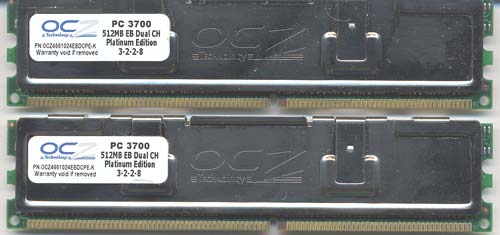
The OCZ 3700EB DIMMs have the Platinum heatspreader that OCZ uses to identify their top-performing Platinum series memory.

As is often the case with memory manufacturers, OCZ buys the blanks from a memory chip maker, then sorts according to their internal specs, and marks them with their own logo. OCZ tells us the EB chips are made for them by several chip makers, but the 3700EB chips are from Micron.
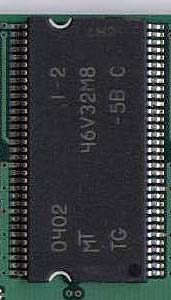
This is certainly a break from the Hynix chips that we are accustomed to seeing in recent high-end memory designs. Micron is also the manufacturer of the tiny BGA chips that impressed us in the Kingmax DDR500 review. It is clear, with EB and tiny BGA, that Micron is back as a player in the high-speed memory market.
OCZ 3700EB Specifications
| OCZ 3700EB Memory Specifications | |
| Number of DIMMs & Banks | 2 DS |
| DIMM Size Total Memory |
512 MB 1 GB |
| Rated Timings | 3-2-3 at DDR466 |
| Rated Voltage | 2.8V |
We confirmed the SPD timings to be set at 3-2-3-8. This is to provide the best compatibility with the widest range of motherboards. We found the best performance at DDR466 on Intel 865/875 chipsets to be at 3-2-3-5, and on AMD nForce3 boards to be 3-2-3-10. At speeds less than about DDR460, a CAS setting of 2.5 works well on both Intel and AMD motherboards.
The 3700EB modules are rated at 2.8V, and are said to handle higher voltages without a problem. Most boards can supply 2.8V vDIMM, but some boards top out at 2.7V or lower, so please check your motherboard specs before purchasing. We found that the OCZ 3700EB performed fine at 2.5V at DDR400, DDR433 and DDR466. However, EB modules handle voltage fine and respond to higher voltages with lower memory timings. Also, the higher overclocks did require voltages of 2.8V or higher.
Intel Performance Test Configuration
For consistency, we first tested on our standard Intel Pentium 4 Memory testbed. The hardware for evaluating OCZ 3700EB is the same used in our earlier reviews of DDR400 and faster Memory.OCZ 3500EB: The Importance of Balanced Memory Timings
Mushkin PC3200 2-2-2 Special: Last of a Legend
PMI DDR533: A New Name in High-Performance Memory
Samsung PC3700: DDR466 Memory for the Masses
Kingmax Hardcore Memory: Tiny BGA Reaches For Top Speed
New Memory Highs: Corsair and OCZ Introduce DDR550
OCZ PC3700 Gold Rev. 2: The Universal Soldier
OCZ 4200EL: Tops in Memory Performance
Mushkin PC4000 High Performance: DDR500 PLUS
Corsair TwinX1024-4000 PRO: Improving DDR500 Performance
Mushkin & Adata: 2 for the Fast-Timings Lane
Searching for the Memory Holy Grail - Part 2
All test conditions were as close as possible to those used in our earlier memory reviews.
| INTEL 875P Performance Test Configuration | |
| Processor(s): | Intel Pentium 4 2.4GHz (800MHz FSB) |
| RAM: | 2 x 512MB OCZ 3700EB (DS) 2 x 512MB OCZ 3500EB (DS) 2 x 512MB Mushkin 2-2-2 Special (DS) 2 x 512MB PMI4200 Gold (DDR533 DS) 4 x 256MB Samsung PC3700 (DDR466 SS) 2 x 512MB Kingmax DDR500 Hardcore Series (DS) 2 x 512MB Kingmax DDR466 Hardcore Series (DS) 2 x 512MB Corsair XMS4400v1.1 TwinX (DS) 2 x 512MB OCZ PC4400 DC Kit (DS) 2 x 512MB OCZ PC3700 Gold Rev. 2 (DS) 2 x 512MB OCZ 4200EL(DS) 2 x 512MB Mushkin PC4000 High Performance (DS) 2 x 512MB Corsair TwinX4000 PRO (DS) 2 x 512MB Mushkin Level II PC3500 (DS) 2 x 256MB Adata DDR450 (SS) 2 x 512MB Adata PC4000 (DS) 2 x 512MB Corsair PC4000 (DS) 2 x 512MB Geil PC4000 (DS) 4 x 256MB Kingston PC4000 (SS) 2 x 256MB Kingston PC4000 (SS) 2 x 512MB OCZ PC4000 (DS) 4 x 256MB OCZ PC3700 GOLD (DS) |
| Hard Drives | 2 Western Digital Raptor Serial ATA 36.7GB 10,000 rpm drives in an Intel ICH5R RAID configuration |
| PCI/AGP Speed | Fixed at 33/66 |
| Bus Master Drivers: | 875P Intel INF Update v5.00.1012, SATA RAID drivers installed, but IAA NOT installed |
| Video Card(s): | ATI 9800 PRO 128MB, 128MB aperture, 1024x768x32 |
| Video Drivers: | ATI Catalyst 4.5 |
| Power Supply: | Vantec Stealth 470 Watt Aluminum |
| Operating System(s): | Windows XP Professional SP1 |
| Motherboards: | Asus P4C800-E (875) with 1016 Release BIOS |
OCZ tests for 3-2-3 compatibility on nVidia nForce2/nForce3, VIA K8T800/Pro, Intel 865/875, and SiS 655TX chipsets. While we have found the fastest performance on Intel 865/875 to be achieved at Cycle Time or tRAS of 5, we have found that the best performance on nForce family chipsets is often achieved with a tRAS of 8 or even as high as 12.
Test Settings
We ran our standard suite of memory performance benchmarks. The following settings were tested with OCZ 3700EB:- 800FSB/DDR400 - the highest stock speed supported on 875/865 and K8T800/nF3/SiS755 motherboards.
- 866FSB/DDR433 - a common rating and overclock for high-speed memory.
- 933FSB/DDR466 - the rated speed of OCZ 3700EB.
- 1000FSB/DDR500 - a standard speed rating that we have used in testing the highest speed memory available.
- Highest Stable Overclock - the highest settings we could achieve with this memory and other memory that we have tested.
Intel Test Results: OCZ 3700EB
To be considered stable for test purposes, Quake3 benchmark, UT2003 Demo, Super PI, Aquamark 3, and Comanche 4 had to complete without incident. Any of these, and in particular Super PI, will crash a less-than stable memory configuration.| OCZ 3700EB (DDR466) - 2 x 512Mb Double-Bank | |||||
| Speed | Memory Timings & Voltage | Quake3 fps | Sandra UNBuffered | Sandra Standard Buffered | Super PI 2M places (time in sec) |
| 400DDR 800FSB |
2.5-2-3-5 2.5V |
322.0 | INT 2752 FLT 2769 |
INT 4460 FLT 4452 |
131 |
| 433DDR 866FSB |
2.5-2-3-5 2.5V |
350.2 | INT 3024 FLT 3007 |
INT 4838 FLT 4837 |
121 |
| 466DDR 933FSB |
3-2-3-5 2.5V |
377.9 | INT 3214 FLT 3218 |
INT 5201 FLT 5202 |
113 |
| 500DDR 1000FSB |
3-2-3-5 2.75V |
403.5 | INT 3484 FLT 3486 |
INT 5581 FLT 5585 |
105 |
| 524DDR 1048FSB |
3-2-3-6 2.85V |
415.0 | INT 3639 FLT 3703 |
INT 5922 FLT 5891 |
100 |
At DDR466, OCZ 3700EB was able to run our complete memory test suite at SPD timings. The DIMMs were stable at the standard 2.5V to 2.6V at the rated timings at DDR466, which is even lower voltage than specified. As we saw in our earlier EB review, the memory can handle voltage and rewards higher voltage with even better timings at the high end. We achieved the best performance on the Intel test bed with the lowest Cycle Time (tRAS) that we could run. Therefore, tRas on Intel chipsets should be set at 5 or 6 for the best performance, rather than the 8 set in SPD.
Intel Performance Comparisons
Performance of the OCZ PC3700EB was compared to all of the memory recently tested on the Intel 875 memory test bed in:OCZ 3500EB: The Importance of Balanced Memory Timings
Mushkin PC3200 2-2-2 Special: Last of a Legend
PMI DDR533: A New Name in High-Performance Memory
Samsung PC3700: DDR466 Memory for the Masses
Kingmax Hardcore Memory: Tiny BGA Reaches For Top Speed
New Memory Highs: Corsair and OCZ Introduce DDR550
OCZ PC3700 Gold Rev. 2: The Universal Soldier
OCZ 4200EL: Tops in Memory Performance
Mushkin PC4000 High Performance: DDR500 PLUS
Corsair TwinX1024-4000 PRO: Improving DDR500 Performance
Mushkin & Adata: 2 for the Fast-Timings Lane
Searching for the Memory Holy Grail - Part 2
Memory performance was compared at DDR400, DDR500 and the highest stable overclock we could achieve that would run Quake 3, UT2003, and Super PI to 2MM places. Where the data was available, comparisons were also made at DDR433 and DDR466.
We have included memory based on Winbond BH5 chips, Mushkin 3500 Level II and OCZ 3500 Platinum Ltd for reference in these comparisons, but none are available for purchase in the marketplace. All discontinued products will be removed from future benchmark comparisons. Since Mushkin claims availability of Mushkin 3200 2-2-2 Special for the next 2 to 3 months, it will be included in memory benchmark comparisons until it is no longer available for purchase.
Results are compared for Quake 3, Sandra UNBufferred Memory Test, and Super PI. SiSoft Sandra 2004 reports 2 results for each memory test - an Integer value and a Float value. Results reported in our charts are the result of averaging the INT and FLOAT scores, which are normally close in value. In other words, INT and FLOAT scores were added and divided by 2 for our reported score.
We have also included additional Memory Benchmarks for Athlon 64 to these standard tests on the Intel 875. Please refer to the Athlon 64 test data for comparisons of memory performance at the same CPU clock and different memory speeds. This can be found starting on Page 11.
DDR400 Charts
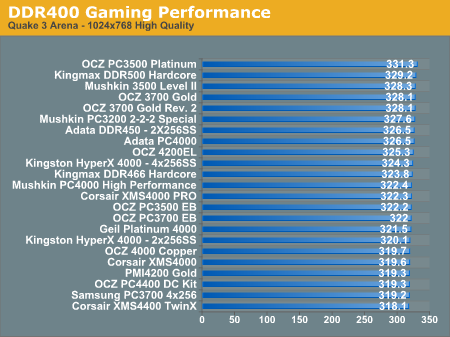
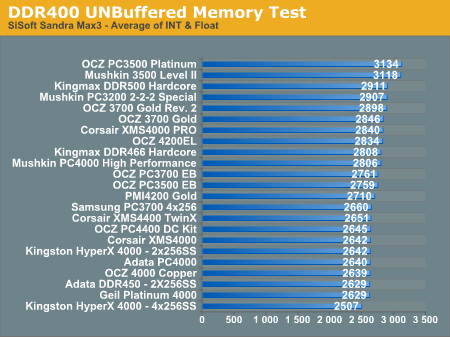
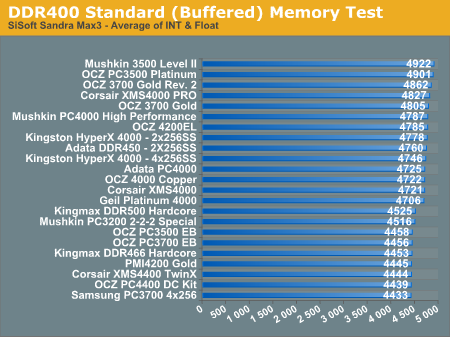
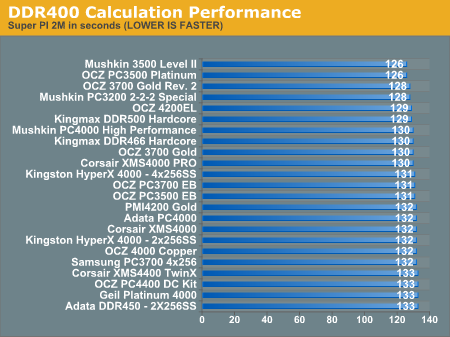
DDR433 Charts
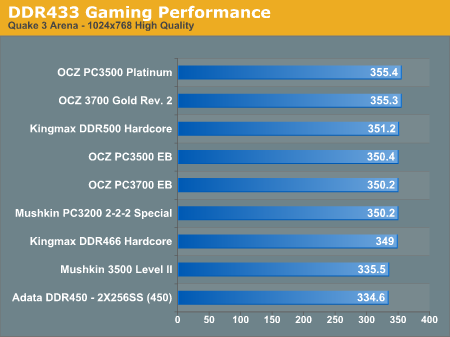
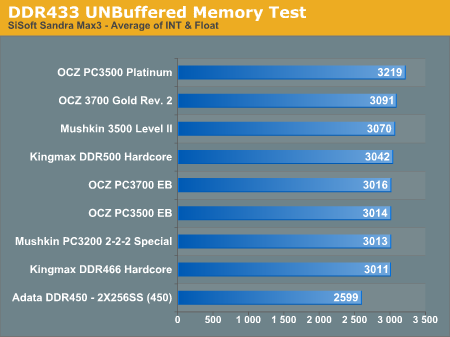
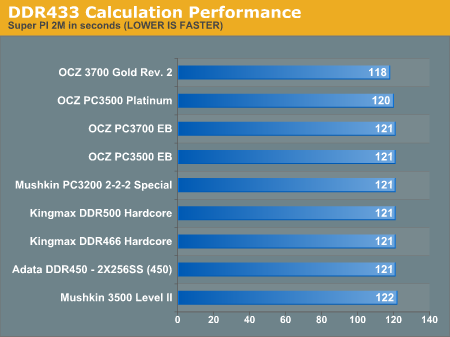
DDR466 Charts
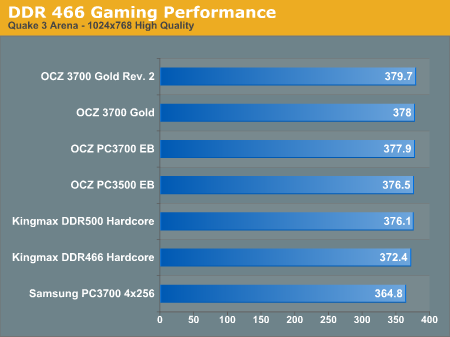
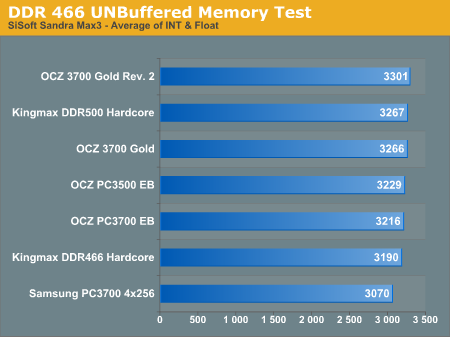
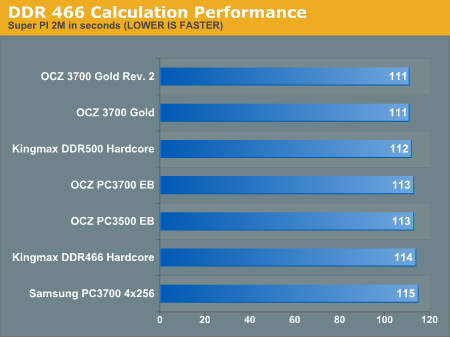
DDR500 Charts
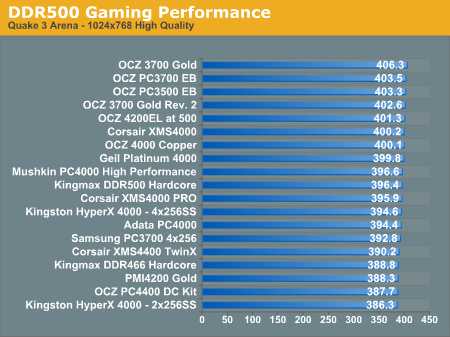
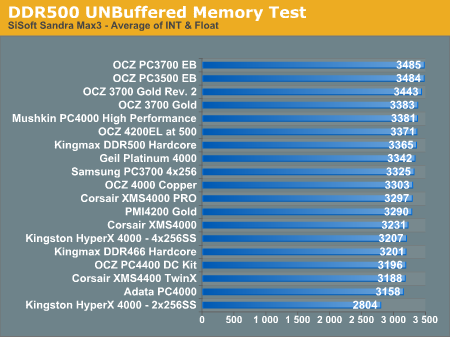
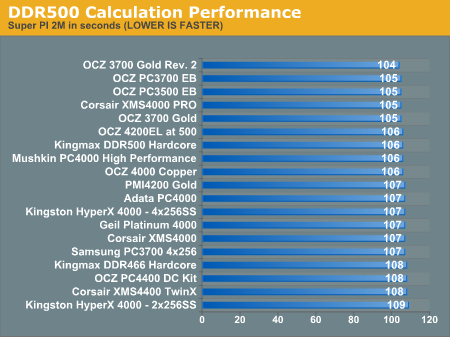
Highest Memory Speed Charts
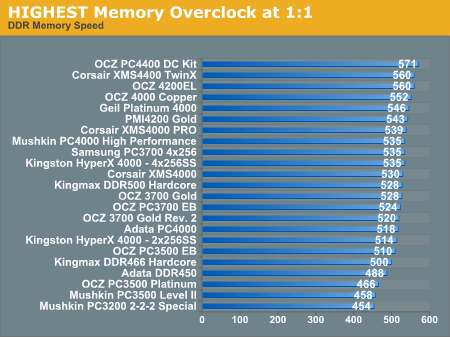
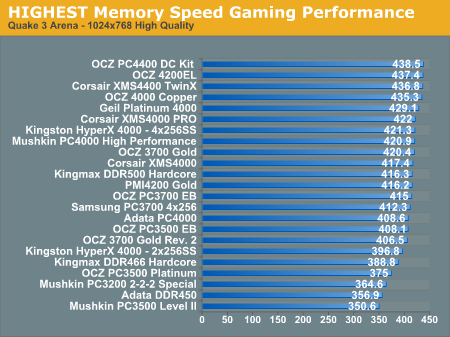
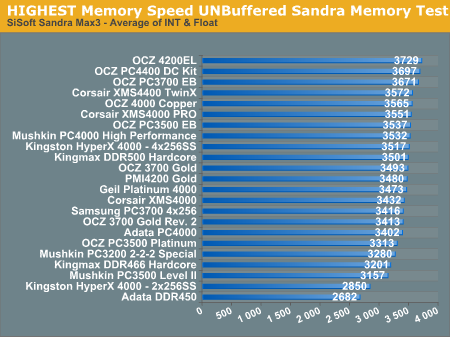
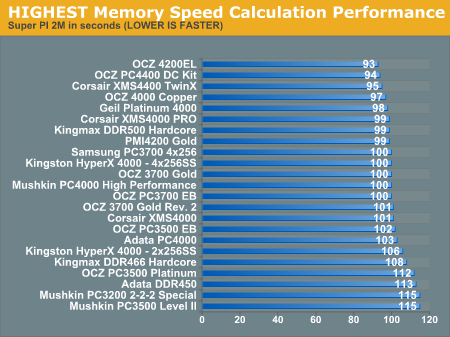
AMD Athlon 64 Performance Test Configuration
The recently introduced nForce3-250 and VIA K8T800 PRO chipsets finally bring a working PCI/AGP lock to Athlon 64. Earlier chipsets only had a working AGP/PCI lock on a handful of boards, such as the AOpen AK89 Max. Thus far, we have tested the Epox, MSI, Chaintech, and Gigabyte nF3-250 chipset motherboards and found a working AGP lock on all boards. The working AGP/PCI lock allows effective testing of Athlon 64 memory performance.All test conditions were as close as possible to those used in our earlier memory reviews.
| Athlon 64 Performance Test Configuration | |
| Processor(s): | AMD Athlon 64 3200+ |
| RAM: | 1 x 512MB OCZ 3700EB (DS) |
| Hard Drives: | Seagate 120GB IDE 7200 RPM (8MB Buffer) |
| PCI/AGP Speed: | Fixed at 33/66 |
| Chipset Drivers: | nVidia Platform Drivers 4.24 (May 10, 2004) |
| Video Card(s): | ATI 9800 PRO 128MB, 128MB aperture, 1024x768x32 |
| Video Drivers: | ATI Catalyst 4.5 |
| Power Supply: | Vantec Stealth 470 Watt Aluminum |
| Operating System(s): | Windows XP Professional SP1 |
| Motherboards: | Chaintech VNF3-250 with Beta Bios 5/07/04 |
In our testing with nForce3-250 boards, we found that the best performance with OCZ 3700EB was achieved at a tRas setting of 10. All Performance Tests were run with a 10 setting.
Test Settings
The Athlon 64 also has the unique feature of unlocked multipliers below the rated speed, which is not available on current Pentium 4 processors. The unlocked lower ratios combined with a working AGP lock makes it possible to take a different approach to testing memory performance on the Athlon 64. The AGP/PCI lock makes it possible to look at a fixed Processor speed and variable Memory speeds to see the real impact of just higher memory speeds on typical performance.The standard Quake 3 (Open GL), Super PI (raw calculation performance), SiSoft Sandra 2004 Standard Buffered memory test (synthetic memory test), and SiSoft Sandra 2004 Standard UNBuffered memory test were run as usual. However, to test more effectively the effect of memory speed on performance, we expanded the benchmarks used for testing. UT2003 (Direct X 8) and Aquamark 3 (Direct X 9) were added to the memory tests to provide a broader range of performance measurements.
AMD Test Results: Stock 3200+ Speed
The first consideration was the impact of memory speed on stock performance. The 3200+ runs at a speed of 2.0GHz with a stock 10x200 ratio. Performance was compared of the standard 10x200 to 8x250, which is also a processor speed of 2.0GHz. With the CPU operating at the same speed, the only influences on performance are the higher memory speed and the higher bus multiplier.| Standard CPU Speed and Variable Memory Speed OCZ 3700EB (DDR466) - 1 x 512Mb Double-Bank |
||
| Benchmark | 3200+ (2.0GHz) 200x10 4xHT 2.5-2-3-10 |
3200+ (2.0GHz) 250x8 3xHT 3-2-3-10 |
| Super PI 2M Places |
100 seconds | 97 seconds |
| Quake 3 FPS |
406.5 | 420.0 |
| Sandra Memory Test Standard Buffered |
INT 3108 FLT 3106 |
INT 3857 FLT 3857 |
| Sandra Memory Test Standard UNBuffered |
INT 1796 FLT 1819 |
INT 2183 FLT 2233 |
| UT2003 FPS |
Flyby 267.7 Botmatch 103.7 |
Flyby 270.5 Botmatch 105.7 |
| Aquamark 3 Standard Score Run |
43,448 | 44,056 |
Slower memory timings were required at DDR500 (250x8) at 3-2-3-10 than the 2.5-2-3-10 needed at DDR400 (200x10). Stock HyperTransport was 4X, and this needed to be lowered to 3X at the 250 multiplier. Despite the slower memory timings at 250x8, you can see that the faster memory speed clearly outperforms slower memory speed with a bit better timings.
Athlon 64 3200+ Performance Charts
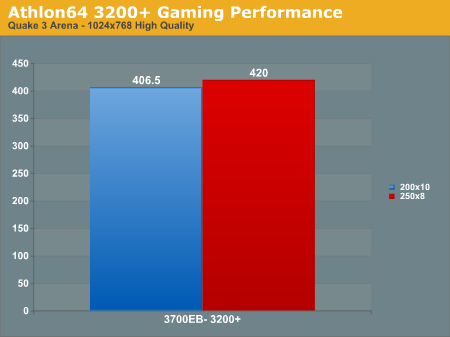
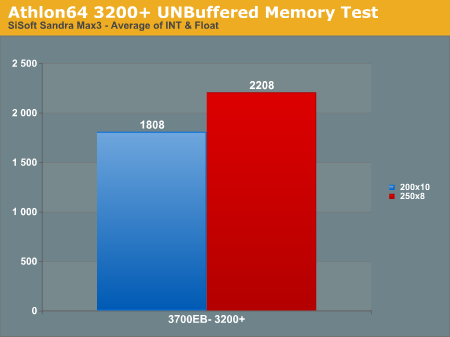
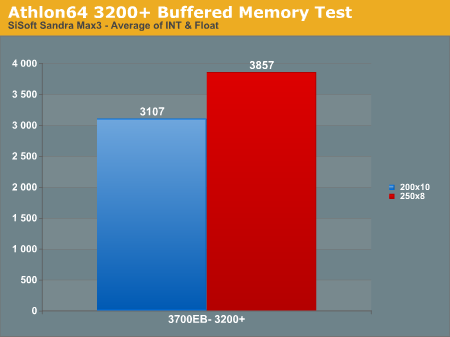
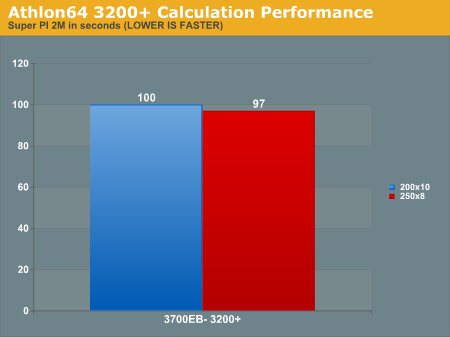
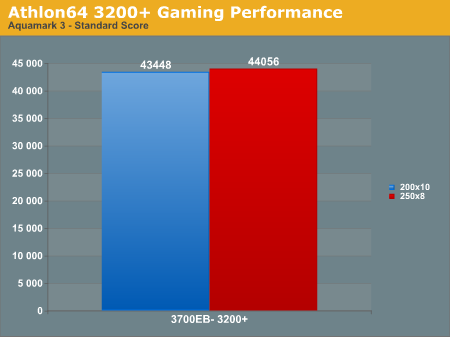
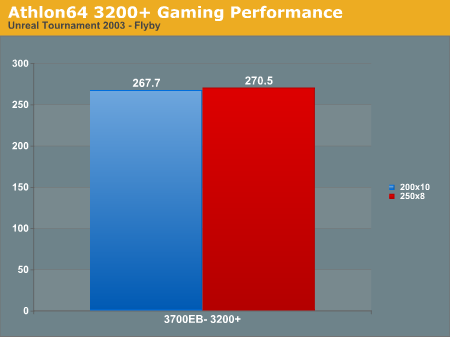
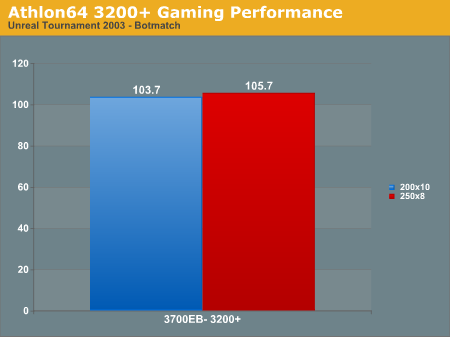
AMD Test Results: Overclocked
We then looked at the highest overclocked speed that we could reach with our early 3200+ and OCZ 3700EB. While a stable 275x7 was possible, a higher processor speed was possible at a stable 268x8. As demonstrated in the review of the AOpen AK89 Max, the more recent 3200+ processors have much greater overhead and overclock much further.While this is a modest processor overclock, the memory is running at a significantly higher speed as a result of the lower multipliers. In fact, we reached DDR536 to DDR550 (268 to 275) with the OCZ 3700EB on the Chaintech nForce3-250 compared to the DDR524 maximum reached on the Intel 875 using the same memory. In fairness, we are running single-channel on the Athlon 64 compared to Dual-Channel on the P4. Dual-Channel on Athlon 64 arrives next month with the new Socket 939 for Athlon 64.
Using the 2142MHz as the standard overclocked speed, we compared performance at the same overclocked processor speed and 3 different memory speeds: DDR428 (214), DDR478, and DDR536. The CPU is running at the same speed in all 3 tests; only the memory speed is varied by using different ratios.
| Fixed CPU Overclock and Variable Memory Speed OCZ 3700EB (DDR466) - 1 x 512Mb Double-Bank |
|||
| Benchmark | 2142 MHz 214x10 4xHT 2.5-2-3 |
2142 MHz 238x9 3xHT 3-2-3 |
2142 MHz 268x8 3xHT 3-2-3 |
| Super PI 2M Places |
95 seconds | 93 seconds | 92 seconds |
| Quake 3 FPS |
424.7 | 433.4 | 446.7 |
| Sandra Memory Test Standard Buffered |
INT 3306 FLT 3304 |
INT 3656 FLT 3653 |
INT 4137 FLT 4137 |
| Sandra Memory Test Standard UNBuffered |
INT 1913 FLT 1939 |
INT 2110 FLT 2142 |
INT 2354 FLT 2404 |
| UT2003 FPS |
Flyby 274.2 Botmatch 108.9 |
Flyby 276.6 Botmatch 110.8 |
Flyby 279.6 Botmatch 112.7 |
| Aquamark 3 Standard Score Run |
43,952 | 44,297 | 44,575 |
Lower memory timings and HyperTransport was required at the higher memory speeds. Despite those performance handicaps, you can see that higher memory speed is providing the best performance, even in simple calculation benchmarks like SuperPI.
The impact of Memory Speed on performance at a fixed CPU speed is even clearer in the Performance Charts.
Athlon 64 Overclocked Performance Charts
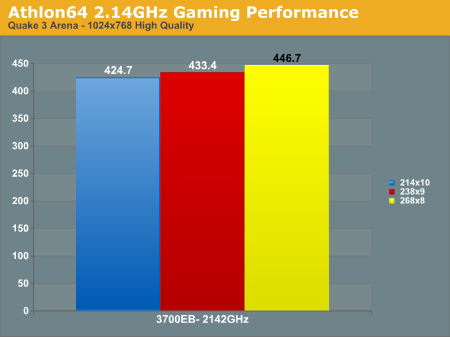
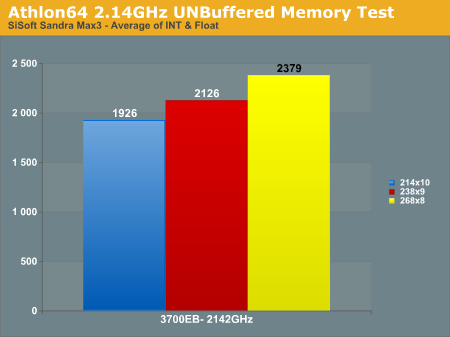
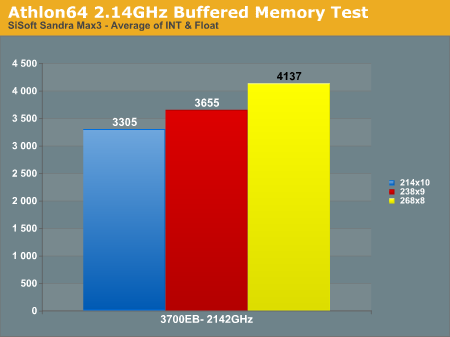
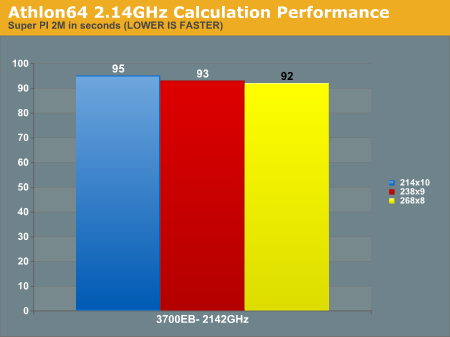
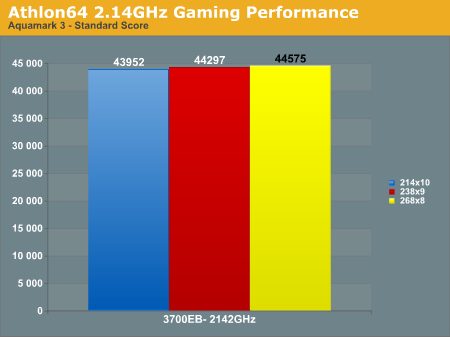
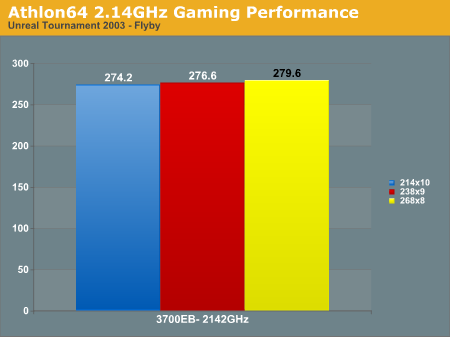
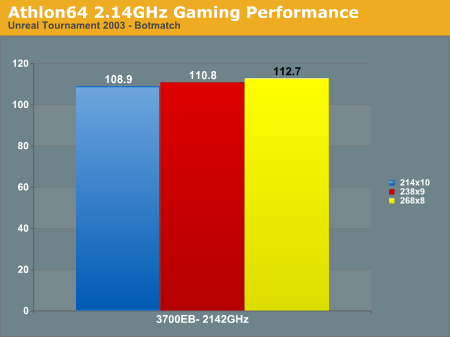
Conclusion
OCZ is breaking new ground with their latest Enhanced Bandwidth series, and 3700EB extends the EB performance envelope. While rated at DDR466, we were able to reach a stable DDR524 on our Intel test bed and an even more remarkable DDR550 on our AMD nForce3-250 test platform. We purposely did not push 3700EB beyond the voltage limits of the test motherboards, which were 2.85V to 2.9V because this is what you can buy in the marketplace. But, we did some experimentation with 3700EB and found that it responds very well to even higher voltage. With motherboards that have been modified to supply 3.0V to 3.2V, DDR500 timings of 2.5-2-2 are very possible. If you decide to try this, please watch out for overheating. 3700EB can handle higher voltages but it gets very hot with increased voltage and you need to supply additional cooling for the memory.Performance curves for 3700EB on the Intel testbed were similar to those we saw with 3500EB, it is just that 3700EB reaches a higher speed at the top. It is worth noting that 3700EB performed very well at stock voltage all the way to DDR466, which is an improvement compared to 3500EB. As we found with 3500EB, the memory is not as fast as some current CAS 2 memory at DDR400, but its performance is very close to the best, even though EB is rated at CAS 2.5. However, in the DDR433 to DDR466 range, 3700EB performed neck-and-neck with the best memory that we have tested, even though the CAS latency was slower. By DDR500, OCZ 3700EB reached the highest bandwidth that we have yet seen at DDR500, the same as 3500EB, even though it ran at CAS 3 and the other fast memories were at CAS 2.5. At the highest Intel speed of DDR524, EB is performing about the same as memory tested at DDR560. This is a solid confirmation of the Enhanced Bandwidth that OCZ claims to deliver with EB. It certainly looks like the more you overclock EB, the greater the impact of the EB optimizations.
Now that high speed memory is no longer a waste on AMD Athlon 64 platforms, we were amazed at how well OCZ 3700EB performs on a Chaintech VNF-250 motherboard with the nVidia nForce3-250 chipset. 3700EB reached an even higher DDR550 on the Athlon 64, and delivered some of the best memory performance that we have ever seen in our gaming and calculation benchmarks. Future memory benchmarks will include both Athlon 64 and Intel motherboards, now that either platform can be used to test memory performance effectively. The AMD platform now offers some additional advantages with both AGP/PCI lock and adjustable ratios, and we are looking forward to seeing how other new DDR memory performs on the new AMD chipsets.
3700EB is an outstanding performer over a very wide range on both the Intel and AMD platforms. It certainly belongs on your short list if you are looking for Intel DDR memory. Frankly, for Athlon 64, we would be hard-pressed to choose any other memory over 3700EB or 3500EB for the nForce3-250/K8T800 PRO or other boards that support working PCI/AGP locks on Athlon 64. 3700EB is simply astounding on Athlon 64.
When Dual-Channel arrives with Socket 939 next month, we should see a 2% to 5% increase in these already outstanding performance results. We will then see if OCZ 3700EB is the same brilliant performer in Athlon 64 Dual-Channel that we have seen on the Single-Channel Socket 754.







